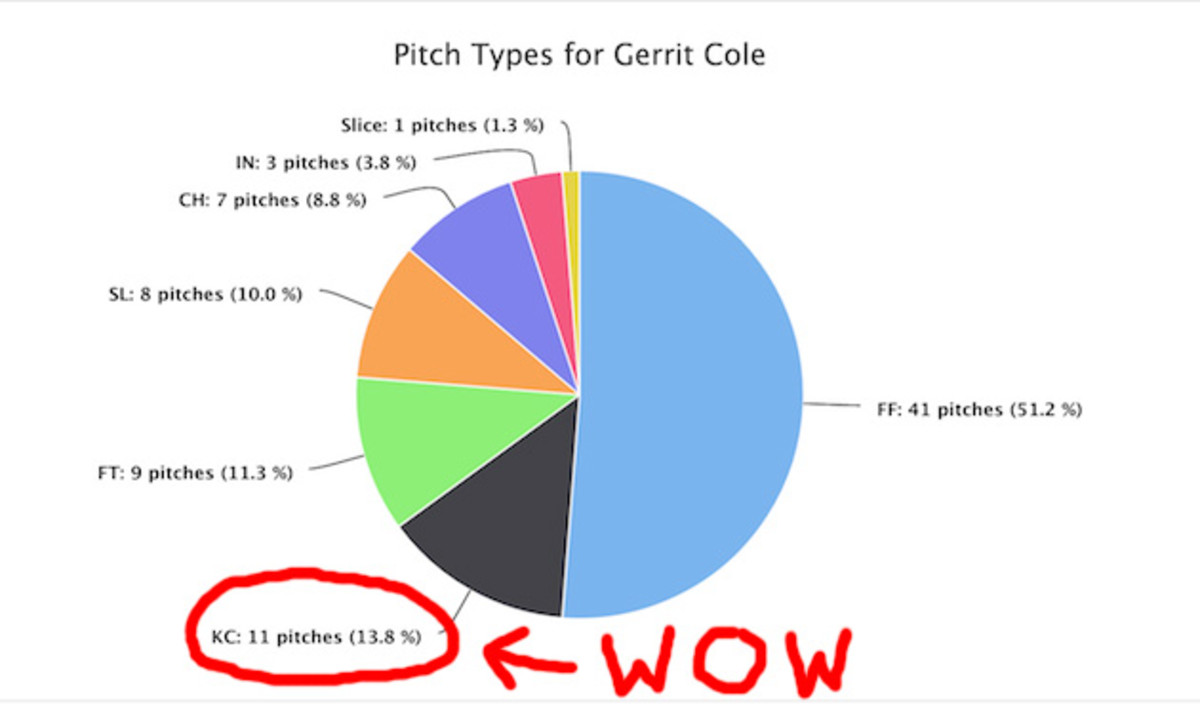Did Pirates SP Gerrit Cole come back from the DL with a new pitch?

Pirates SP Gerrit Cole made his return last weekend after spending a month on the DL with a triceps injury. He took a loss against the Nationals, allowing four earned runs on seven hits in four innings, striking out five and walking two. Poor defense hurt him in his last frame, but it certainly wasn’t his sharpest outing of the season. It was a shake-the-rust-off outing against a first-place team that appears headed toward an NL East crown.
Cole’s season-long numbers have regressed this season, typified by a strikeout rate that has dipped to 19.4%, but that, too, isn’t what we’re after in this column. No, it was an unexpected entry in Cole’s Pitch F/X data that made last Saturday’s start in Washington noteworthy.

According to Pitch F/X, Cole threw 11 knuckle-curveballs and zero regular curves in his first start back from the DL. That was curious, given that Pitch F/X had never previously coded a knuckle-curve from Cole in 8,309 career pitches. Did Cole really break out a new offering? And is there any chance the new pitch derives from his triceps injury in an effort to keep him on the mound with the Pirates needing a strong second half to make the playoffs for the fourth consecutive season?
• Weekend Streams: Nola, Taillon headline list of best pitching options
Let’s take a look at a regular Cole curveball, a pitch that Pitch F/X tells us Cole has thrown 111 times this season.
That’s a pretty standard plus-curveball. It’s a little loopier than a traditional 12-to-6 curveball, but that’s more in line with the sort of curve we see from pitchers in today’s game. I was hoping to find a clip where the broadcast zoomed in on Cole’s pitch grip for the curve, but it was not to be. Cole’s curve registers in the low-80s on average, which is also an expected curveball velocity for a guy whose fastball sits in the mid-90s. Beyond being an obviously plus-pitch, there isn’t much more to note about the offering.
• Hitting report: How Jose Altuve turned himself into an MVP candidate
Just for fun, let’s also examine Cole’s slider, a pitch he has thrown 218 times this year. At the risk of stating the obvious, curveballs and sliders are different pitches with different characteristics, but the fact that both are breaking balls that move down and away from the pitching-hand side can sometimes cause confusion for a pitch-coding system, even one as sophisticated as Pitch F/X.
The obvious differences between a curve and a slider are the nature of the break, as well as the velocity. Cole’s slider checks in at 87 mph on average, and has that Frisbee-style break to it, unlike the 1-to-7 break he gets on his curve. As we can see in the strikeout of Addison Russell, he can tighten up the slider to give it more of a cut-fastball tendency, as well. There’s always a slight risk, but we shouldn’t run into any problems of a slider coding as a knuckle-curve, giving the obvious slider qualities of Cole’s go-to breaking ball.
• Pitching report: Pirates’ Glasnow provides glimpse into future in debut
Alright, now that we’ve set the control element of our experiment, let’s get back to last Saturday. Just to refresh your memory, Pitch F/X tells us that Cole threw 11 knuckle-curves in the game against zero regular curveballs. Did Cole really break out a new offering after logging more than 8,300 pitches in his career, or was this just a coding mistake? That’s a question we can answer with a little help from Ben Revere.
There’s no doubt that this is a new pitch. We’ve rarely seen a curveball from Cole that has such sharp, downward break of the 12-to-6 variety. The ones we looked at earlier had far more shape to them, relying more on horizontal movement to break into or out of the strike zone from east to west. This curve gets by purely on its vertical break, and that’s a hallmark of the knuckle-curve.
• Buy, Sell, Hold: Even with strikeouts, Stanton worth hefty trade price
As A.J. Burnett, a former teammate of Cole’s, or Mike Mussina could tell you, spiking one finger—the knuckle in the knuckle-curve—creates that violent over-the-top break that gives the pitch its 12-to-6 movement. What we typically call a curveball today is thrown with a different grip with two fingers flat on the ball, and while the arm action gives it more vertical break than a slider, it’s not quite the fall-off-the-table break we see from Cole in this strikeout of Revere. It now appears that Burnett shared more than just a rotation with Cole. He may have also helped teach him how to throw the pitch that made his career.
Here’s another one of the first 11 knuckle-curves of Cole’s career.
The pitch he threw to Revere wasn’t a lone knuckle-curve in the curveball wilderness. Cole added a new pitch to his repertoire during his month on the shelf, or at least his time off convinced him to break out an offering he had been sitting on for some time. It will be a welcome addition to an arsenal that already boasted a strong cache of breaking balls.
